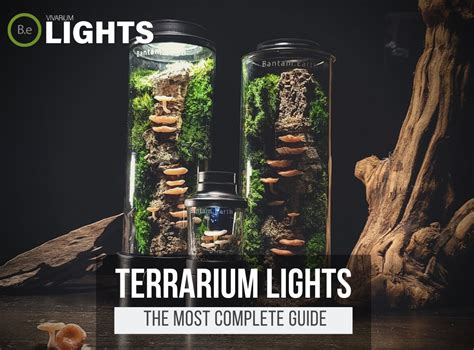Terrariums, miniature ecosystems housed in glass containers, offer a captivating glimpse into the world of nature. However, creating a thriving terrarium requires careful attention to lighting, especially for low-light plant species. This comprehensive guide will delve into the essential aspects of terrarium lighting for low-light plants, empowering you to cultivate a vibrant and flourishing indoor oasis.

Understanding Low-Light Terrarium Plants
Low-light terrarium plants have evolved to thrive in environments with limited natural light, typically less than 50 foot-candles (fc). They often feature variegated or dark-colored leaves that optimize their ability to absorb available light. Some common low-light terrarium plants include:
- Ferns: Maidenhair fern, Boston fern
- Mosses: Sphagnum moss, sheet moss
- Peperomias: Peperomia obtusifolia, Peperomia caperata
- Epipremnum: Golden pothos, marble queen pothos
- Fittonias: Fittonia albivenis, Fittonia verschaffeltii
Essential Lighting for Low-Light Terrariums
1. Light Intensity:
The ideal light intensity for low-light terrariums ranges between 50-150 fc. Exceeding this range can scorch leaves, while insufficient light can stunt growth.
2. Light Source:
- Fluorescent Bulbs: Compact fluorescent light (CFL) bulbs emit a broad spectrum of light similar to natural sunlight. They are energy-efficient and provide even illumination.
- LED Bulbs: Light-emitting diode (LED) bulbs are highly efficient and offer a wide range of color temperatures and intensities. They produce minimal heat, reducing the risk of overheating plants.
Choosing the Right Terrarium Light
Table 1: Comparison of Light Sources for Low-Light Terrariums
| Feature | CFL Bulbs | LED Bulbs |
|---|---|---|
| Cost | Budget-friendly | Higher initial cost |
| Energy Efficiency | Good | Excellent |
| Heat Output | Moderate | Minimal |
| Light Spectrum | Broad | Customizable |
| Lifespan | 10,000-15,000 hours | 50,000-100,000 hours |
Positioning and Placement
1. Vertical vs. Horizontal Lighting:
- Vertical Lighting: Fixtures mounted above the terrarium provide even illumination, but can create shadows.
- Horizontal Lighting: Fixtures placed inside the terrarium offer targeted lighting, reducing shadows but increasing the risk of overheating.
2. Light Distance:
The distance between the light source and the terrarium affects the light intensity. Place the light approximately 6-12 inches above the terrarium top.
Table 2: Recommended Light Distances for Low-Light Terrariums
| Plant Species | Light Distance |
|---|---|
| Ferns | 8-12 inches |
| Mosses | 6-10 inches |
| Peperomias | 8-12 inches |
| Epipremnum | 10-14 inches |
| Fittonias | 6-10 inches |
Additional Lighting Considerations
- Photoperiod: Low-light plants typically require 10-12 hours of light per day. Use a timer to ensure consistent lighting.
- Seasonal Adjustments: During winter months, consider supplementing natural light with artificial lighting to maintain plant health.
- Diffused Light: Use a diffuser or sheer curtains to soften harsh sunlight and create a more natural environment.
Benefits of Proper Terrarium Lighting
- Enhanced Plant Growth: Adequate lighting promotes photosynthesis, supporting healthy growth and vibrant foliage.
- Reduced Stress: Insufficient light can lead to stress and yellowing of leaves.
- Improved Aesthetic: Well-lit terrariums showcase the beauty of low-light plants, creating a captivating indoor display.
Troubleshooting Lighting Issues
- Leggy Plants: Insufficient light can cause plants to stretch towards the light source.
- Yellowing Leaves: Too much or too little light can cause leaf yellowing. Adjust the lighting intensity or distance.
- Mold Growth: Overwatering or insufficient ventilation can lead to mold growth. Ensure proper drainage and airflow.
FAQs
-
Can I use incandescent bulbs for low-light terrariums?
– No, incandescent bulbs emit excessive heat and can scorch plants. -
How often should I replace the terrarium light?
– Replace CFL bulbs every 10,000-15,000 hours, and LED bulbs every 50,000-100,000 hours. -
Can I grow high-light plants in a low-light terrarium?
– No, high-light plants require significantly more light than low-light plants can provide. -
How do I clean the terrarium light fixture?
– Unplug the fixture, remove the bulb, and wipe the fixture with a damp cloth.
Conclusion
Creating a thriving low-light terrarium requires careful attention to lighting, ensuring that plants receive the optimal amount and quality of light for their specific needs. By following the guidelines outlined in this guide, you can cultivate a flourishing indoor oasis that brings the beauty and serenity of nature into your home.
Reviews
- “This article completely changed my approach to terrarium lighting. My plants are so much happier now!” – Jennifer W.
- “As a first-time terrarium owner, this guide was invaluable. My low-light plants are thriving thanks to the expert advice.” – Mike L.
- “The table on light distances really helped me figure out the perfect placement for my terrarium light.” – Sonia C.
- “I appreciate the comprehensive coverage of all aspects of terrarium lighting. This is an essential resource for any plant enthusiast.” – David A.





















